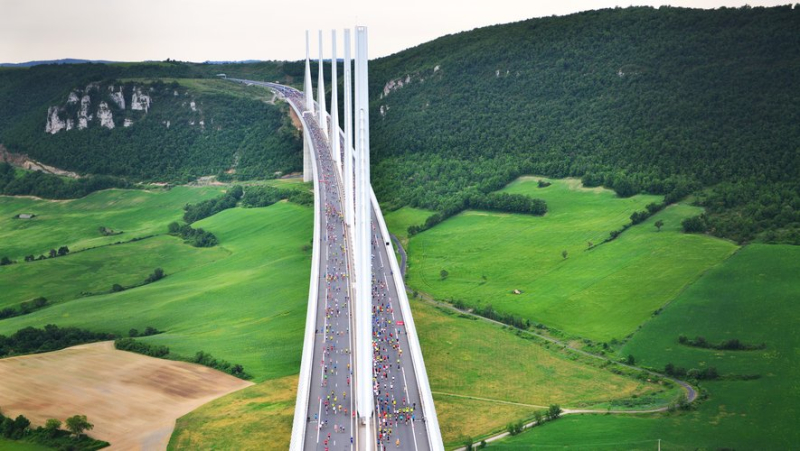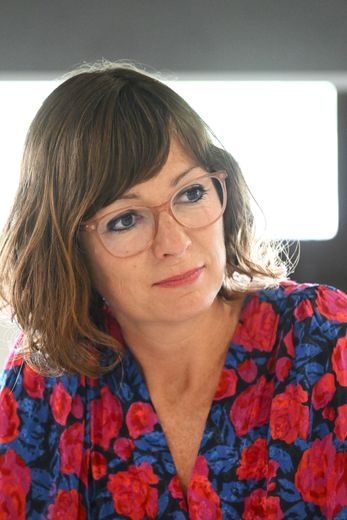Twenty years ago, the Millau Viaduct, then a superstar and national pride, made the French dream

La course du viaduc de Millau aura lieu cette année le 22 septembre. EVA TISSOT
Flashback. In the early 2000s, half a million people came to visit the bridge construction site. This national glory celebrates its twentieth anniversary in September, three months early, at the initiative of the Millau town hall and Eiffage. Story of a hysteria.
Twenty years ago, everyone was fighting over it. Fortunately, it was solid. TV news, tour operators for tourists, politicians came to seek a little of its light on its apron: a handful of years after France's victory in the 98 World Cup, the viaduct emerged from the Millau fog as a new national pride, an emblem in the style of industrial, technological and architectural cock-a-doodle-doo. It was an Englishman, Sir Norman Foster, who invented its sleek lines, but that doesn't matter.
20 days of celebration from September 3 to 22
The City of Millau and Eiffage are celebrating the 20th anniversary of the Millau Viaduct three months early (it was December 14) by offering 20 days of celebration, from September 3 to 22.
On the menu, in particular, the (free) concert by Yannick Noah on the Maladrerie site on September 20 (6:30 p.m.), the Eiffage Race from Millau viaduct on September 22, a conference on the construction of the viaduct on September 6 (6:30 p.m., Maison du peuple).
The world record for pile height (245 metres), on the banks of the Tarn, inflamed chauvinistic aesthetes as one cherishes an icon. 500,000 people had come to admire the construction site, according to an estimate by Eiffage, before the end of 2004.
A man symbolised the camp of feverish supporters, even if it meant mixing in a touch of opportunism: Christian Cabiron had just bought the Leclerc supermarket under the viaduct in 2003. Jackpot. Postcards of the viaduct were selling like hotcakes. Eiffage had to call him to order: he was selling T-shirts bearing the “viaduct” logo without authorisation. Eiffage also balked, before letting it happen, when he decorated the roof of his service station with pylons and guy wires. Until the end, the king of oil!
20 years later, Christian Cabiron is still there. His supermarket has just been transferred back to the Lerclerc fold. The guy wires still stand above the fuel pumps.
Guided tours still organized
Guided tours of the viaduct are organised at 11am, 2pm and 4pm, all year round (6€ adults, 4€ children (free for under 6s), from the viaduct rest area (which can be accessed off the motorway). 05 65 61 61 54.
The roundabout directly above the viaduct has been renamed after Marc Legrand. “He was the engineer of the viaduct”, according to Jean-Louis Calvet, the mayor of the village of Creissels, which has five of the seven piers of the viaduct in its commune. bridge. Marc Legrand, who disappeared three years ago, was in fact the CEO of the Compagnie Eiffage du viaduc de Millau (CEVM), a subsidiary of the group in charge of construction and operation. Errare humanum est.
Jean-Louis Calvet has only been mayor of Creissels since 2020. His predecessor, Pierre Garlenc, who was in charge for thirty years, died eleven years ago. He was alongside the mayor of Millau, Jacques Godfrain (still very much alive and a tireless ambassador for the viaduct) at the inauguration of the structure on December 14, 2004. Jacques Chirac, President of the Republic at the time, is no longer there either.
The explosion of toll rates in twenty years
The comparison is enough to make your skin crawl: toll rates have exploded in twenty years.
From 6.50 euros in the summer, we have gone to 13.30 euros for cars (+104.6%) while inflation, in the meantime, only corresponds to an increase of 40% (in other words a ticket that should cost 9 euros).
It's worse for heavy goods vehicles: €20.30 versus €46 (+125%).
Before the viaduct, a certain José Bové
Millau didn't wait for the viaduct to be famous… Two years before the first mechanical shovels, another construction site hit the headlines in 1999: José Bové, another national pride in the moustachioed Asterix version fighting against junk food, dismantled the Millau McDonald's under construction. A fight that recalled another: that of Larzac, thirty years earlier.
But Millau was above all its traffic jams in the middle of summer, motorists trapped in the basin at the foot of the causses. Some stopped in town. Millau's past spoke for itself: from the archaeological site of La Graufesenque, where 600 potters produced tableware 2,000 years ago, to the more recent activity of leather and skins, successful tanneries, tawries and glove makers.
“The viaduct effect”
And then came the slightly crazy idea of flying over Millau. In that sky, the birds of ill omen announced the death of the city, certainly freed from traffic jams but also from passing tourist traffic.
The glory of the bridge, a cult superstar object, came to chase away the dark clouds. For a time… Because what was quickly baptized with the name "Viaduct effect" fell like a soufflé in 2007, barely three years after the end of the construction. 20 years later, the six years of grace are behind him. All that remains is pride and admiration, unchanged.
And more than the bridge, it is the A75 which now facilitates travel to Millau, to enjoy another local treasure, much older: its landscapes and its “full nature” playground. open air.

Emmanuelle Gazel: “People come for Millau (…) and its major events”. Photo Jean-Michel Mart
“The viaduct put Millau on the world map”
20 years ago, Emmanuelle Gazel, the mayor of Millau, was 25 years old. The time of the construction site corresponded to her professional geographical distance. She returned in 2005 but followed the progress of the construction site on each of her visits. “I remember the moment when the two parts of the bridge were to join, with the curve we wondered if it would join correctly.”
20 years later, she is still delighted that the viaduct has “put Millau on the world map” and that this notoriety has boosted the tourism sector. “People come for Millau, especially with major events that extend the wings of the season. Tourism has been growing steadily since I became mayor (2020, Editor's note), the Covid phenomenon has allowed a new dynamic of attractiveness."
One regret, the disappearance of the World Pétanque Championship, "but we will have the French championship next year". She fought against the installation of a brand village in La Cavalerie, a project "completely outdated", she says and still blocked by appeals. He wanted to rely on the A75. “It is around Millau and Saint-Affrique that commercial development must take place.”
As for criticism of Eiffage's low investment in city life in Millau, while a lot of money is generated at the toll, the mayor slips in a little message: “We are in favor, with the scarcity of public finances, of Eiffage providing more support. If they chose to increase their local roots a little, that would be welcome.”
I subscribe to read the rest




